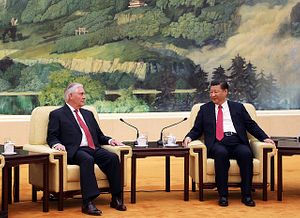The U.S. administration of President Donald J. Trump has had a rough ride in domestic politics terms, largely as a result of its own mismanagement. Several weeks ago, as if hoping to use foreign policy to restore his sagging approval ratings, Trump lobbed Tomahawk cruise missiles at Syria and then dropped the most powerful conventional bomb in its arsenal on Afghanistan. The Trump administration has also signaled that it is open to using military force to stop North Korea’s nuclear and missile program.
For some years, the South China Sea was viewed as the next flashpoint. More recently, however, the focus appears to have moved to the Middle East and North Korea. Conditions in the South China Sea have certainly been calm for the roughly nine months since the Permanent Court of Arbitration handed down its arbitral award in July 2016 in favor of the Philippines, in its dispute with China. However, China has steadily advanced its project of militarizing the South China Sea.
According to a report by the Asia Maritime Transparency Initiative (AMTI), China has built a hangar and a radar on a man-made island in the Spratly Islands. Facilities for deploying ground-to-air missiles have also been completed. The radar deployed to the man-made island in the Spratly Islands is capable of monitoring a considerably wide air and sea space. Moreover, China can attack the Philippines mainland from the South China Sea if and when missiles and fighters are deployed to the Spratly Islands. In addition, China has expanded its facilities on the Paracel Islands, where it has been confirmed that Beijing has deployed J-11 fighters.
Under President Xi Jinping, China was expected to fill in the Scarborough Shoal and establish an air defense identification zone in the airspace over the South China Sea, seeking to prevent political opponents in China and abroad from criticizing the arbitral award as a diplomatic blunder. However, that issue was shelved, in effect, because President Rodrigo Duterte of the Philippines made clear his interest in economic cooperation with China. Consequently, China appears to have judged that now is not the time to start trying to change the status quo, even though it has already expanded its existing facilities on the Spratly Islands and the Paracel Islands.
China also carefully watched the change of government in the United States. Since his campaign, Trump has repeatedly talked tough about China in connection with the South China Sea and the U.S. trade deficits. The president also hinted at one point at a review of his country’s One-China policy regarding Taiwan, the most sensitive issue for China. Xi was able to coax Trump into a statement that he would “honor the One-China policy” in a telephone conversation between the two leaders in early February 2017. China must be hoping to avoid the souring of its relationship with the United States over the South China Sea issues ahead of the National Congress of the Communist Party of China, scheduled to take place in the fall of 2017.
For the time being, China will focus on negotiations with countries belonging to the Association of Southeast Asian Nations (ASEAN) to establish a Code of Conduct for parties in the South China Sea (COC). China and ASEAN members are aiming to present a framework for the COC in June 2017 at the earliest. They are focusing their discussions on points such as the waters to which the COC applies, whether to prioritize dispute resolution or crisis management and how to penalize violations. However, it will not be easy for China and ASEAN members to reach an agreement on these points.
The optimistic view – namely that the United States will not create a headache for China over the South China Sea issue because it needs China’s cooperation on North Korea – appears to be spreading in China. In fact, when moving from Southeast Asia to the Korean Peninsula, the aircraft carrier USS Carl Vinson circumvented the South China Sea and sailed to the Philippine Sea, although this was only a detour to conduct combined military drills with the Japan Maritime Self-Defense Force in the Philippine Sea.
The Trump administration will likely pressure China in the South China Sea, hoping that will in turn encourage Beijing to increase its own pressure on North Korea. Since its inauguration, the Trump administration has not carried out any Freedom of Navigation (FON) operations, but U.S. Pacific Command Commander, ADM Harry Harris, testified before the U.S. Congress that the U.S. Navy is planning FON operations in the South China Sea. If the operations get the green light, they may be carried out more frequently in more sensitive waters compared with their counterparts under the Obama administration. China will have to oppose the operations when they do occur.
In short, the current situation is merely the calm before the storm. The diplomatic calendar in Southeast Asia reveals a succession of major events due to take place in the upcoming months, including the ASEAN Regional Forum (ARF), the Asia-Pacific Economic Cooperation (APEC) and the East Asia Summit. Trump is also scheduled to make a round of visits in the region. Along with the Korean Peninsula, the South China Sea will remain a flashpoint for Asia.
Tetsuo Kotani is a Senior Fellow at the Japan Institute of International Affairs.

































